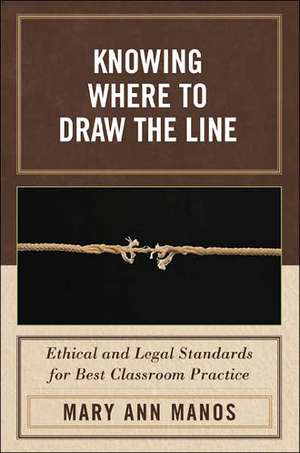Knowing Where to Draw the Line
Autor Mary Ann Manosen Limba Engleză Paperback – 10 aug 2007
| Toate formatele și edițiile | Preț | Express |
|---|---|---|
| Paperback (1) | 277.02 lei 6-8 săpt. | |
| Rowman & Littlefield – 10 aug 2007 | 277.02 lei 6-8 săpt. | |
| Hardback (1) | 344.63 lei 6-8 săpt. | |
| Bloomsbury Publishing – 29 sep 2006 | 344.63 lei 6-8 săpt. |
Preț: 277.02 lei
Nou
Puncte Express: 416
Preț estimativ în valută:
53.01€ • 57.81$ • 44.70£
53.01€ • 57.81$ • 44.70£
Carte tipărită la comandă
Livrare economică 24 aprilie-08 mai
Preluare comenzi: 021 569.72.76
Specificații
ISBN-13: 9781578866182
ISBN-10: 1578866189
Pagini: 150
Dimensiuni: 155 x 222 x 10 mm
Greutate: 0.27 kg
Editura: Rowman & Littlefield
ISBN-10: 1578866189
Pagini: 150
Dimensiuni: 155 x 222 x 10 mm
Greutate: 0.27 kg
Editura: Rowman & Littlefield
Notă biografică
Descriere
Instructs teachers on how to deal with students, parents, administrators, and local communities, covering an exhaustive list of legal issues such as sexual harassment, discipline, contract negotiations, liability, and medical concerns.
Cuprins
Foreword: Education and the Law by Sandra HolmanChapter 1. Professional Dispositions: Building a Professional PersonaChapter 2. Drawing the Line with StudentsChapter 3. Drawing the Line with ParentsChapter 4. Drawing the Line with the School AdministrationChapter 5. Drawing the Line with the CommunityAppendix: Ethic Codes of EducatorsNotesIndex
Recenzii
The text is current, relevant, without obvious omissions, and interesting because of its contemporary applications and conversational writing..Defining topics using ordinary educational situations before stating case law allows citations to be presented in context, and case studies applying cited laws using contemporary, problematic dilemmas with detailed rationales explaining solutions also promote clarity and compliance.
One out of every five teachers will be either the plaintiff, the defendant, or a grievant in an action that is job related! From that startling starting point, Manos and several Illinois colleagues begin their discussion of what the required law course in teacher education should cover, the importance of being familiar with state ethics codes, and drawing the line ethically/legally with students, parents, administrators, and the community. Chapters include cases in point and critical thinking questions. The appendix presents the codes of ethics of the National Education Association, American Association of School Administrators, and related groups.
One out of every five teachers will be either the plaintiff, the defendant, or a grievant in an action that is job related! From that startling starting point, Manos and several Illinois colleagues begin their discussion of what the required law course in teacher education should cover, the importance of being familiar with state ethics codes, and drawing the line ethically/legally with students, parents, administrators, and the community. Chapters include cases in point and critical thinking questions. The appendix presents the codes of ethics of the National Education Association, American Association of School Administrators, and related groups.
